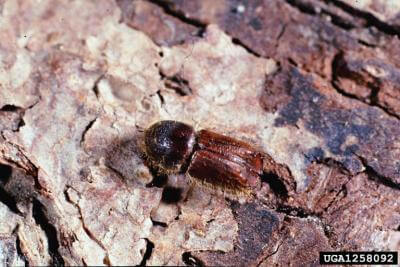
The European spruce beetle is found across Europe and Asia (USDA APHIS & Forest Service, 2000), where it causes considerable damage. This beetle is one of the most commonly detected pests traveling on solid wood packing material, even after the adoption of the 1995 regulations intended to prevent introductions of bark-associated insects (USDA APHIS & Forest Service, 2000). Several times, the beetle has been found in dunnage or warehouses after inspections (Hofacker, 1993; LaGasa et al. 1997; USDA APHIS & Forest Service, 2000); fortunately, in these cases the pest was eradicated before it became established. The European spruce beetle carries various fungi, some of which can be extremely pathogenic. If introduced beetles were accompanied by a virulent fungus, and native beetles also spread the fungus, “It could be as disastrous to North American spruce as the Dutch elm disease was to elms” (USDA Forest Service, 1991).
USFS scientists and managers developed a conservation priority-setting framework for forest tree species at risk from pest & pathogens and other threats. The Project CAPTURE (Conservation Assessment and Prioritization of Forest Trees Under Risk of Extirpation) uses FIA data and expert opinion to group tree species under threat by non-native pests into vulnerability classes and specify appropriate management and conservation strategies. The scientists prioritized 419 tree species native to the North American continent. The analysis identified 15 taxonomic groups requiring the most immediate conservation intervention because of the tree species’ exposure to an extrinsic threat, their sensitivity to the threat, and their ability to adapt to it. Each of these 15 most vulnerable species, and several additional species, should be the focus of both a comprehensive gene conservation program and a genetic resistance screening and development effort. European Spruce Beetle is not known to be a threat to any of these 15 most vulnerable species.
Source
Potter, K.M., Escanferla, M.E., Jetton, R.M., Man, G., Crane, B.S., Prioritizing the conservation needs of US tree spp: Evaluating vulnerability to forest insect and disease threats, Global Ecology and Conservation (2019), doi: https://doi.org/10.1016/



